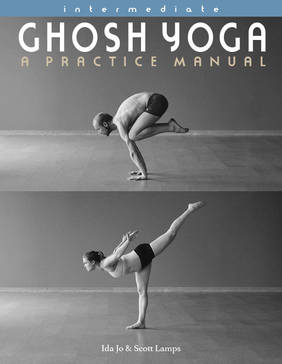|
As beginners we come to yoga with no experience, looking to turn curiosity into first-hand experience. As we progress, we become familiar with our body and mind.
We transition into intermediate practitioners as we develop proficiency and ease in the beginning exercises and concepts of yoga. This process generally takes one to two years of regular practice (5-7 times per week). Often, with dedicated practice you will notice yourself paying more attention to detail and with a growing interest in deeper yogic concepts like self-awareness, humility, peace and contentment. The transition from beginning to intermediate practioner is a gradual process. The desire for “progress” is often a driving factor to practice but the daily unfolding of newly found awareness is something to treasure. Take pleasure in the daily findings of your yoga practice. With regards to the physical practice of yoga—the exercises in this book—the in- termediate practitioner can begin to ask more of his or her body, mind and spirit. These exercises demand more strength, flexibility, balance, awareness and control than beginning exercises. The body will develop quickly. The challenge for the intermediate practitioner is to avoid the trappings of the ego. As our proficiency grows, we must be careful that our ego doesn’t grow as well. Muscles develop, will-power develops, posture improves and confidence grows. But these exercises are not an end in themselves. They are designed to keep the body strong and able to proceed on a spiritual journey. We must strive for humility even as we improve our bodies and minds. It is okay to feel proud of our progress, but we must not let pride consume us. In the exercises, focus not only on your improving strength, flexibility, balance and grace, but also on the big-picture integrity of your body in the posture. Each position, when done correctly, honors the laws of physics, geometry and anatomy. We cannot change the way our bodies are put together nor the pull of gravity, but we can learn to work with them instead of ignoring or fighting them. When we recognize and respect these rules, we quickly come into harmony with ourselves and the world around us. Excerpt from the Intermediate Practice Manual.
1 Comment
Michael Rose
11/12/2021 12:47:23 pm
I practice everyday for 30 minutes. I have a weak left leg due to a severe motorcycle accident where I fractured my pelvis in multiple places. My left leg s thinner than my right and I have some numbness. Can you suggest how to improve
Reply
Leave a Reply. |
AUTHORSScott & Ida are Yoga Acharyas (Masters of Yoga). They are scholars as well as practitioners of yogic postures, breath control and meditation. They are the head teachers of Ghosh Yoga.
POPULAR- The 113 Postures of Ghosh Yoga
- Make the Hamstrings Strong, Not Long - Understanding Chair Posture - Lock the Knee History - It Doesn't Matter If Your Head Is On Your Knee - Bow Pose (Dhanurasana) - 5 Reasons To Backbend - Origins of Standing Bow - The Traditional Yoga In Bikram's Class - What About the Women?! - Through Bishnu's Eyes - Why Teaching Is Not a Personal Practice Categories
All
Archives
May 2024
|







 RSS Feed
RSS Feed